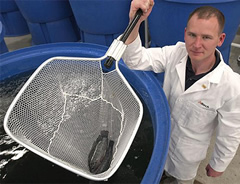Farm Fresh Fish - The Challenges and Potential for Aquaculture

Ben Shafer, Research Technician at
Alltech's Aquaculture Research Center
in Nicholasville, Kentucky
Controversy around Aquaculture
What is the truth about aquaculture? Is it the potential savior of Earth's wild fish species or is it driving them ever more rapidly to the brink of extinction? The Blue Food Revolution, an article in the February 2011 Scientific American, provides an extraordinarily balanced overview of the aquaculture industry and some of the up and coming technologies that may help to push aquaculture toward true sustainability.
Protein for a Growing World
By 2050 the world's population is predicted to rise to 9.3 billion. How can we provide enough food, especially protein, for all of those hungry mouths? Agriculture requires arable land and fresh water, both of which are in short supply. Increased fishing doesn't seem to be a viable option as wild fish populations are already plummeting. Can aquaculture help to fill the gap?
Aquaculture and Pollution
One of the main complaints about aquaculture is the water pollution often associated with conventional coastal fish farms. Fish waste and food scraps from these farms clouds the shallow waters, causes algal blooms and kills marine life beneath the pens. Innovative fish farmers and researchers are working on offshore alternatives to coastal pens. Kona Blue Water Farms, featured in The Blue Food Revolution, are raising yellowtail in enormous submerged cages anchored offshore, where strong currents carry the waste out to the open ocean where it is diluted and consumed by plankton.
Aquaculture and Fishmeal
Many of the most popular aquaculture species are large predatory fish like tuna and salmon. These fish command high prices at market so it is easy to see why fish farmers have focused on them. With the collapse of wild tuna fisheries, it seems like farm-raised tuna and salmon would be heralded as a sustainable substitute to endangered wild species. Farmed fish may not be wild fish but they eat wild fish, usually fishmeal made from anchovies and sardines. These small forage fish support the ocean?s food chain so overfishing of anchovies and sardines could decimate marine life as a whole.
Aquaculture is growing at 7.5% per year. As production increases it will become ever more important to reduce or eliminate wild fish as a feed source. Progress has been made in recent decades. It was once common practice to feed whole sardines to aquaculture stocks. In many places this practice has been replaced by feeding formulated, aquaculture feed that is made up of fishmeal, soybean meal, other ingredients. Soybeans, and many other commodity crops are in short supply already, and they require a lot of land and water. If aquaculture is to lessen the pressure on land and water use then we need to minimize the amount of agricultural products that go into fish feed.
Aquaculture and Algae
Maybe we need to look a little lower on the food chain than sardines and anchovies for fish food. Algae are at the very bottom of the marine food chain and the source of the omega-3 fatty acid DHA that make fish such a healthy food. Algae are already being produced as a source of DHA supplements for infant formula, milk and juice. Algae may help the aquaculture industry find true sustainability.
What Do You Think?
What is the best way to minimize the environmental impact of aquaculture and move toward sustainability?
What Next?
We believe that algae can be used to address a wide range of environmental, agricultural, health and energy problems. We are exploring the potential for algae at our first annual Algae conference, Algae: The Growth Platform (February 22nd - 24th, 2011, Lexington, Kentucky, USA)
All Categories
Archives
- 五月 2014 (6)
- 二月 2014 (1)
- 八月 2013 (1)
- 七月 2013 (1)
- 六月 2013 (4)
- 五月 2013 (17)
- 九月 2012 (1)
- 八月 2012 (22)
- 七月 2012 (1)
- 五月 2012 (24)
- 四月 2012 (2)
- 三月 2012 (12)
- 一月 2012 (7)
- 十二月 2011 (10)
- 十一月 2011 (12)
- 十月 2011 (2)
- 九月 2011 (4)
- 八月 2011 (12)
- 七月 2011 (10)
- 六月 2011 (11)
- 五月 2011 (35)
- 四月 2011 (4)
- 三月 2011 (10)
- 二月 2011 (12)
- 一月 2011 (13)







